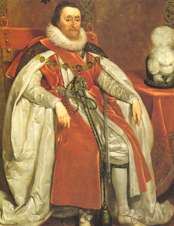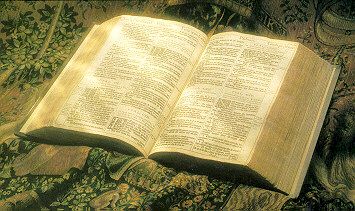![]()
Part IX: The King James Bible
 In 1603,
King James VI of Scotland succeeded Queen Elizabeth and took the throne in England as King
James I. The Elizabethan age had brought a flowering of poetry and drama with writers such
as Spenser, Marlowe, and Shakespeare. The stage was set for a translation of the Bible
that, together with Shakespeare, would have a great influence on the English language and
become the most cherished Bible translation of all time.
In 1603,
King James VI of Scotland succeeded Queen Elizabeth and took the throne in England as King
James I. The Elizabethan age had brought a flowering of poetry and drama with writers such
as Spenser, Marlowe, and Shakespeare. The stage was set for a translation of the Bible
that, together with Shakespeare, would have a great influence on the English language and
become the most cherished Bible translation of all time.
James I had been brought up with Protestant convictions, and before he even took the throne in London he was approached by a group of puritans with the "Millenary Petition." This petition requested Church reform, and was signed by 800 clergy. The petition prompted the King to call for a conference in 1604 at Hampton Court to address concerns for reform. It was at this Hampton Court conference that Dr. John Reynolds, and influential educator and leader among puritans, presented a strong case for the need of a new translation of the Bible in English. The Bishop’s Bible was the standard in churches, but the Geneva was the most popular translation for private use. The Bishop’s was of inferior quality as a translation, so Reynolds urged the King to either make the Geneva Bible the authorized version of England, or set about the task of creating a better translation. King James, as well as others in England at the time, were not in favor of the Geneva because of its Calvinist commentary. For one thing, he felt some of the notes allowed for disobedience to kings- a marginal note for Exodus 1:9 says that Hebrew midwives were correct in disobeying the Egyptian king, for instance. The bishop of London, Richard Bancroft, was not in favor of a new translation, but consented that if a new translation was to be undertaken, marginal notes must be kept to a minimum. On this the King agreed.
 On July 22, 1604, King James announced a decision that history would show
was the greatest and most memorable of his reign: a new translation of the Bible was to be
undertaken and he had appointed 54 scholars for the project. The translation was to be a
collaborative work, something which was not true of any English Bible that had gone
before. Futhermore, detailed guidelines were set forth for the translation process. The
group of scholars and linguists (numbering 47 by the time the translation was begun) was
divided into six committees. Two committees would work at Oxford, two at Cambridge, and
two in Westminister, and each committee was assigned books of the Bible to translate. The
scholars were proficient in Hebrew and Greek, and used the Massoretic text of the
Complutensian Polyglot (1514-1517) for the Old Testament. For the New Testament they used
the Textus Receptus published by Estienne, Beza, and Stephanus from 1550 onward.
Technically, they were not supposed to create a new English translation, "but make a
good one better, or out of many good ones one principle good one." Therefore they not
only looked at the Greek, Hebrew, and Latin, but carefully consulted prior English
translations, especially the Geneva and Tyndale.
On July 22, 1604, King James announced a decision that history would show
was the greatest and most memorable of his reign: a new translation of the Bible was to be
undertaken and he had appointed 54 scholars for the project. The translation was to be a
collaborative work, something which was not true of any English Bible that had gone
before. Futhermore, detailed guidelines were set forth for the translation process. The
group of scholars and linguists (numbering 47 by the time the translation was begun) was
divided into six committees. Two committees would work at Oxford, two at Cambridge, and
two in Westminister, and each committee was assigned books of the Bible to translate. The
scholars were proficient in Hebrew and Greek, and used the Massoretic text of the
Complutensian Polyglot (1514-1517) for the Old Testament. For the New Testament they used
the Textus Receptus published by Estienne, Beza, and Stephanus from 1550 onward.
Technically, they were not supposed to create a new English translation, "but make a
good one better, or out of many good ones one principle good one." Therefore they not
only looked at the Greek, Hebrew, and Latin, but carefully consulted prior English
translations, especially the Geneva and Tyndale.
|
The Bible Preserved and Passed Down: The King James The 1611 King James is the culmination of the balance between textual accuracy and provision of a Bible for the common man in the English language. |
The reason the King James Version is so rich in the nobility of its language is that the translators were careful to make it so. The text was to be used at church services and read aloud, so the translators would read their versions aloud to one another, and rewrite again and again to achieve the best emphasis of punctuation and the best rhythm in prose. It took three years for the committees of scholars to complete the translation. Then, two scholars were selected for each committee to form a review committee of twelve, and three more years were spent reviewing and revising the work. After another nine months preparing the Bible for press, it was ready to be printed by the King'’ Printer, Robert Barker.
The First Edition was published in London in 1611 in a black-letter folio (10.25" x 15.5"). The "1611 First Edition" actually has two versions, called "He" Bibles and "She" Bibles. The "He" editions have Ruth 3:15 rendered as "he went into the city, while the "She" editions read, "she went into the city." Despite the careful translation process of the King James, numerous typographical errors appear in the First Edition "He" and "She" Bibles. The 1613 Edition is similar to the 1611, but there are over 400 variations in the text, mostly because of typographical mistakes. Nevertheless, the King James was an instant success, immediately replacing the Bishop’s as the version of choice in churches and for public reading. By the 1650’s, it also surpassed the Geneva as the most commonly used translation for personal Bible reading as well.
| Title page of the First Edition King James, 1611 A.D. | Luke 1 from the First Edition King James, 1611 A.D. |
The King James Version is commonly called the "Authorized Version," but in reality King James never declared it the official Bible of England. Yet his approval of the Bible, its eloquence in language, and its scholarly translation made it the indisputable authority as the Word of God. It was over 250 years before a revision of the text was attempted, when the English Revised Version was published. Even the editors of that version said of the King James, "We have had to study this great Version carefully and minutely, line by line; and the longer we have been engaged upon it the more we have learned to admire its simplictiy, its dignity, its power…" Today, nearly four hundred years after its first printing, it is still greatly loved for its artistic beauty and inspirational translation of the original Hebrew and Greek Scriptures.
Even as the Bible is a precious treasure, the King James Bible is a treasure among Bible translations. No work of English literature has sold more copies or been so widely used. It is a masterpiece of literary art, an achievement of Biblical scholarship, a memorial to martyr sacrifices, a landmark to the birth of a nation, and a testimony to God’s love.
Museum Store coming soon - check back
Own a rare, original page from a First Edition Bible from 1611, beautifully preserved in museum conservation framing! These pages are limited in quantity and are ideal for collectors, investors, or churches. They are perfect for display in church foyers, business offices, home decorating, and as special gifts.
Copyright © 1998-2002, The Ancient Page